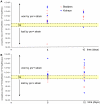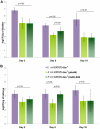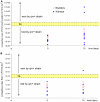Plasmidic qnrA3 enhances Escherichia coli fitness in absence of antibiotic exposure
- PMID: 21915350
- PMCID: PMC3168526
- DOI: 10.1371/journal.pone.0024552
Plasmidic qnrA3 enhances Escherichia coli fitness in absence of antibiotic exposure
Abstract
The widespread presence of plasmid-mediated quinolone resistance determinants, particularly qnr genes, has become a current issue. By protecting DNA-gyrase from quinolones, Qnr proteins confer a low level quinolone resistance that is not sufficient to explain their emergence. Since Qnr proteins were hypothesized to act as DNA-binding protein regulators, qnr genes could have emerged by providing a selective advantage other than antibiotic resistance. We investigated host fitness of Escherichia coli isogenic strains after acquisition of the qnrA3 gene, inserted either alone onto a small plasmid (pBR322), or harbored on a large conjugative native plasmid, pHe96(qnrA3) found in a clinical isolate. The isogenic strains were derived from the susceptible E. coli CFT073, a virulent B2 group strain known to infect bladder and kidneys in a mouse model of pyelonephritis. In vitro experiments included growth analysis by automatic spectrophotometry and flow cytometry, and competitions with CFU enumeration. In vivo experiments included infection with each strain and pairwise competitions in absence of antimicrobial exposure. As controls for our experiments we used mutations known to reduce fitness (rpsL K42N mutation) or to enhance fitness (tetA deletion in pBR322). E. coli CFT073 transformed with pBRAM(PBR322-qnrA3) had significantly higher maximal OD than E. coli CFT073 transformed with pBR322 or pBR322ΔtetA, and in vivo competitions were more often won by the qnrA3 carrying strain (24 victories vs. 9 loss among 42 competitions, p = 0.001). In contrast, when pHe96(qnrA3) was introduced by conjugation in E. coli CFT073, it exerted a fitness cost shown by an impaired growth observed in vitro and in vivo and a majority of lost competitions (33/35, p<0.0001). In conclusion, qnrA3 acquisition enhanced bacterial fitness, which may explain qnr emergence and suggests a regulation role of qnr. However, fitness was reduced when qnrA3 was inserted onto multidrug-resistant plasmids and this can slow down its dissemination without antibiotic exposure.
Conflict of interest statement
Figures




References
-
- Hooper DC. Mechanisms of action and resistance of older and newer fluoroquinolones. Clin Infect Dis. 2000;31(Suppl 2):S24–28. - PubMed
-
- Heisig P. Type II topoisomerases–inhibitors, repair mechanisms and mutations. Mutagenesis. 2009;24:465–469. - PubMed
-
- Goossens H. Antibiotic consumption and link to resistance. Clin Microbiol Infect. 2009;15(Suppl 3):12–15. - PubMed
-
- Jacoby GA. Mechanisms of resistance to quinolones. Clin Infect Dis. 2005;41(Suppl 2):S120–126. - PubMed
Publication types
MeSH terms
Substances
LinkOut - more resources
Full Text Sources
Research Materials

